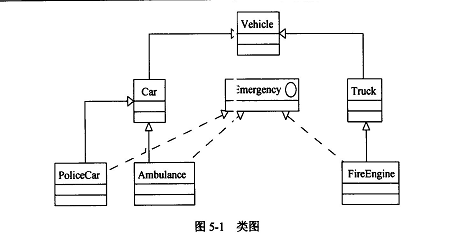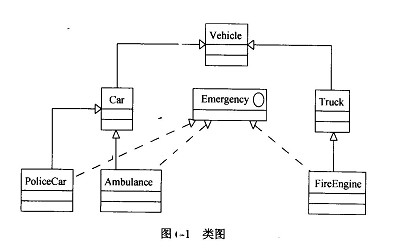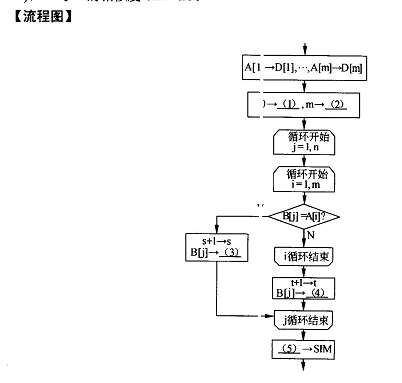阅读以下说明和C函数,填充函数中的空缺,将解答填入答题纸的对应栏内。
【说明】
下面的函数sort(int n,int a[])对保存在数组a中的整数序列进行非递减排序。由于该
序列中的元素在一定范围内重复取值,因此排序方法是先计算出每个元素出现的次数并
记录在数组b中,再从小到大顺序地排列各元素即可得到一个非递减有序序列。例如,
对于序列6,5,6,9,6,4,8,6,5,其元素在整数区间[4,9]内取值,因此使数组元素b[O]~b[5]的下标O~5分别对应数值4~9,顺序地扫描序列的每一个元素并累计其出现的次数,即将4的个数记入b[0],5的个数记入b[l],依此类推,9的个数记入b[5]。最后依
次判断数组b的每个元素值,并将相应个数的数值顺序地写入结果序列即可。
对于上例,所得数组b的各个元素值如下:
那么在输出序列中写入1个4、2个5、4个6、1个8、1个9,即得4,5,5,6,6,6,6,8,9,
从而完成排序处理。
【C函数】
void sort(int n,int a[])
( int *b;
int i, k, number;
int minimum=a[0], maximum=a 0];
/.minimum和maximum分别表示数组a的最小、最大元素值*/
For(i=1;i if ( _(1) ) minimum = a[j]; else if ( _ (2) ) maximum = a[i]; } number = maximum - minimum + 1; if (number<=l) return; b = (int *) calloc (number, sizeod (int) ; if ( !b) return; for(f=0;i k= a[i] - minimum; ++b[k]; } /*按次序在数组a中写入排好的序列*/ l= (3) ; for( k=0; k for(; (4) ;一一b[k] ) a[i++】=minimum+ (5)’ ; }
-
阅读以下说明和C++代码,填充代码中的空缺,将解答填入答题纸的对应栏内。
【说明】
某应急交通控制系统(TraficControISy ,tem)在红灯时控制各类车辆(Vehicle)的通
行,其类图如图5-1所示,在紧急状态下应急车辆红灯时也可通行,其余车辆按正常规
则通行。
下面的C++代码实现以上设计,请完善其中的空缺。

#include
#include
using namespace std;
class Vehicle {/*抽象基类,车辆*/
public :
virtual void run () = 0;
};
class Emergency( /*抽象基类,可在红灯时通行的接口,函数均为纯虚函数*/
public:
(1)=0 //isEmergent()函数接口
(2)=0 //runRedLight()函数接口
};
class Car: public Vehicle {
public :
-car(){ }
void run () { /*代码略*/ }
};
Ciass Truck:public vehicie {
Public;
-Truck(){ }
Void run() { /*代码略*/}
};
Class policecar: (3) {
Private:
bool isEmergency;
public :
PoliceCar () : Car () , Emergency () { this=>isEmergency = false;
}
PoliceCar (bool b) : Car () , Emergency () { this=>isEmergency = b; }
~PoliceCar () { }
bool isEmergent () { ret irn (4) ; }
void runRedLight () { /*代码略*/ }
};
/*类Ambulance. FireEngine/*实现代码略*/
class TraficControISystem {/*交通控制类*/
private :
Vehicle*v[24]; int numVeh: cles./*在构造函数中设置初始值为0*/
public:
void control(){ //控制在紧急情况下应急车辆红灯通行,其他情况按常规通行
for (int i = 0; i<[numVehicles;++] {
Emergency*ev=dynamic_cast
if (ev !=0(5)-: runRedLight ( )
Else (6)-:run()
}
}
Void add(vehicle){v[numvehicles++]=vehicle;}
/*添加车辆*/
Void shutdown(){for (int i =0;i
}
int main () {
TraficControlSystem* tcs =new TraficControlSystem;
tcs->add (new Car () );, t cs->add (new PoliceCar ()) ;
tcs->add (new Ambulance ()) ; tcs- >add (new Ambulance (true)) ;
tcs->add (new FireEngine (true)) ; -.cs->add (new FireEngine ()) ;
tcs->add (new Truck ()) ;
tcs->control () ; tcs->shul Down ( ) ;
delete tcs;
}
-
阅读以下说明和Java代码,填充程序中的空缺,将解答填入答题纸的对应栏内。
【说明】
某应急交通控制系统(TraficControIS,stem)在红灯时控制各类车辆(Vehicle)的通
行,其类图如图6-1所示,在紧急状态下应急车辆在红灯时可通行,其余车辆按正常规
则通行。

下面的Java代码实现以上设计,请完善其中的空缺。
【Java代码】
abstract class Vehicle
public Vehicle () { }
abstract void run
};
interface Emergency {
(1) ;
(2) ;
}
class Car extends Vehicle {
public Car () { }
void run () { /*代码略*/ }
};
class Truck extends Vehicle {
public Truck () { }
void run () { /*代码略*/ }
class PoliceCar (3)
boolean isEmergency = false;
public PoliceCar () { }
public PoliceCar(boolean b) { this . isEmergency =b; }
public boolean isEmergent () { return (4); }
public void runRedLight () { /*代码略*/ }
}
/*类Ambulance. FireEngine实现代码略*/
public class TraficControISystem {/。交通控制类。/
private Vehicle[ ]V=new Vehiele [24];
int numVehicles;
public void control() {
for (int i=0; i
if (v[i] instanceof Enu rgency&& ((Emergency)V [i])
isEmergent()) {
( 5 ) . runRedLigh': ( ) ;
}else
(6).run( )
}
}
void add (Vehicle vehicle) { v[numVehicles++]=vehicle;)/*添加车辆*/
void shutDown()(/*代码略*/}
public static void main (Stri.ng [ ] args) {
TraficControlSystem tcs = new TraficControlSystem() ;
tcs . add (new Car () ;
tcs .add (new PoliceCar () ;
tcs .add (new Ambulance () ;
tcs . add (new Ambulance (true》 ;
tcs . add (new FireEngine ( true》 ;
tcs . add (new Truck () ;
tcs . add (new FireEngine ( ) ;
tcs . control () ;
tcs . shutDown () ;
}
}
-
试题三(共15分)
阅读以下说明和C代码,填充代码中的空缺,将解答填入答题纸的对应栏内。
【说明1】
下面的函数countChar(char *text)统计字符串text中不同的英文字母数和每个英文字
母出现的次数(英文字母不区分大小写)。
【C代码1】
Int countchar(char*text)
{
int i,sum=O; /*sum保存不同的英文字母数*/
char *ptr;
int c[26]={0}; /*数组c保存每个英文字母出现的次数*/
/*c[0]记录字母A或a的次数,c[1]记录字母B或b的次数,依此类推*/
ptr=(1); /* ptr初始时指向字符串的首字符*/
while (*ptr) {
if (isupper (*ptr) )
c[*ptr一’A’]++;
else '
if (islower (*ptr) )
c[*ptr一’a’]++;
(2); /*指向下一个与字符*/
}
for ( i=0. i<26; i++ )
If(3)sum++;
return sum;
}
【说明2]
将下面C代码2中的空缺补全后运行,使其产生以下输出。
f2: f2:f2:2
f3: f3:1
【C代码2]
#include
int fl (int (*f) (int)) .
int f2 (int) ;
int f3 (int) ;
int main ()
{
Printf(“%d\n”,f1(4))
Printf(“%d\n”,f1(5))
return 0;
}
int fl(int (*f) (int) }
{
int n=O;
/*通过函数指针实现函数调用,以返回值作为循环条件*/
While(6) n++
return n;
}
int f2 (int n)
{
printf ("f2: ") ;
return n*n-4;
}
int f3 (int n)
{
printf ("f3: ") ;
return n-1
}
-
阅读以下说明和C程序,填充程序中的空缺,将解答填入答题纸的对应栏内。
【说明】
正整数n若是其平方数的尾部,则称n为同构数。例如,6是其平方数36的尾部,
76是其平方数5776的尾部,6与76都是同构数。下面的程序求解不超过10000的所有
同构数。
已知一位的同构数有三个:1,5,6,因此二位同构数的个位数字只可能是1,5,6
这三个数字。依此类推,更高位数同构数的个位数字也只可能是1,5,6这三个数字。
下面程序的处理思路是:对不超过100 00的每一个整数a,判断其个位数字,若为1、
5或6,则将a转换为字符串as,然后对a进行平方运算,并截取其尾部与as长度相等
的若干字符形成字符串后与as比较,根据它们相等与否来断定a是否为同构数。
【C程序】
#include
#include
#include
int myitoa (int, char*); ,/*将整数转换为字符串*/
/* right取得指定字符串尾部长度为ler gth的子串,返回所得子串的首字符指针*/
char *right (char*, int length);
int main ()
{
int a, t; int len;
char as [10], rs[20];
printf(”[1,10000]内的同构数:\r”);
for (a=l.a<=10000; a++) {
t= (1); /*取整数a的个位数字*/
if (t!=l&&t!=5&&t!=6) :ontinue;
len=myitoa (a, as)j /*数a转换为字符串,存入as*/
myitoa (a*a, rs); /*数a的平方转换为字符串,存入rs*/
/*比较字符串as与rs末尾长度为len的子争是否相等*/
if(strcmp(as,__(2) )**o) /*若相同则是同构数并输出*/
printf(“%s的平方为%s\n”,as,rs);
}
return O;
}
int myitoa (int num,char*s) /*将整数num转换为字符串存入s*/
{
int i,n=0;
char ch;
/*从个位数开始,取num的每一位数字转换为字符后放入s[]*/
while (num) {
s[n++] =(3) +’o';
num=num/10.
}
s[n]=’\0 ‘;
for (i=0; i
(4) ; s[i]= s [n-i-l];s[n-i-1]=ch;
}
return n; /*返回输入参数num的位数*/
}
char *right (char*ms, int length)
/*取字符串ms尾部长度为length的子串,返回所得子串的首字符指针*/
{
int i;
For(;*ms;ms++) /*使ms到达原字符串的尾部*/
for( i=0; i
return ms;
}
-
阅读以下说明和C函数,填充函数中的空缺,将解答填入答题纸的对应栏内。
【说明】
下面的函数sort(int n,int a[])对保存在数组a中的整数序列进行非递减排序。由于该
序列中的元素在一定范围内重复取值,因此排序方法是先计算出每个元素出现的次数并
记录在数组b中,再从小到大顺序地排列各元素即可得到一个非递减有序序列。例如,
对于序列6,5,6,9,6,4,8,6,5,其元素在整数区间[4,9]内取值,因此使数组元素b[O]~b[5]的下标O~5分别对应数值4~9,顺序地扫描序列的每一个元素并累计其出现的次数,即将4的个数记入b[0],5的个数记入b[l],依此类推,9的个数记入b[5]。最后依
次判断数组b的每个元素值,并将相应个数的数值顺序地写入结果序列即可。
对于上例,所得数组b的各个元素值如下:
那么在输出序列中写入1个4、2个5、4个6、1个8、1个9,即得4,5,5,6,6,6,6,8,9,
从而完成排序处理。
【C函数】
void sort(int n,int a[])
( int *b;
int i, k, number;
int minimum=a[0], maximum=a 0];
/.minimum和maximum分别表示数组a的最小、最大元素值*/
For(i=1;i
if ( _(1) ) minimum = a[j];
else
if ( _ (2) ) maximum = a[i];
}
number = maximum - minimum + 1;
if (number<=l) return;
b = (int *) calloc (number, sizeod (int) ;
if ( !b) return;
for(f=0;i
k= a[i] - minimum; ++b[k];
}
/*按次序在数组a中写入排好的序列*/
l= (3) ;
for( k=0; k
for(; (4) ;一一b[k] )
a[i++】=minimum+ (5)’ ;
}
-
试题一(共15分)
阅读以下说明和流程图,填补流程图中的空缺(1)~(5),将解答填入答题纸的
对应栏内。
【说明】
两个包含有限个元素的非空集合A、B的相似度定义为IAUBI/IA U Bl,即它们的交
集大小(元素个数)与并集大小之比。
以下的流程图计算两个非空整数集合(以数组表示)的交集和并集,并计算其相似
度。己知整数组A[1:m】和B【1:n】分别存储了集合A和B的元素(每个集合中包含的元素
各不相同),其交集存放于数组C[1:s】,并集存放于数组D【1:t】,集合A和B的相似度存
放于SIM。
例如,假设A={1,2,3,4},B={1,4,5,6},则C={1,4},D={1,2,3,4,5,
6},A与B的相似度SIM=1/3。

高级经济师考试试题精选练习(1)
高级经济师考试模拟练习题之单选题(1
高级经济师考试试题精选练习(2)
高级经济师考试试题精选练习(3)
高级经济师考试试题:经济法案例试题精
高级经济师考试模拟试题及答案
高级经济师考试试题及答案:单选练习题
高级经济师考试试题:经济法案例试题精
高级经济师考试模拟题及答案练习(1)
高级经济师考试模拟题及答案练习(2)


